The subject of genetics (the study of genes, genetic variation, and heredity in living organisms) is, to say the least, very scientific by nature. However, in this blog, we’ll attempt to unravel the science in easy-to-understand language.

Summary of genetics
From scientific presentations to sci-fi movies, we’ve all seen pictures of the “corkscrewed ladder shape” with its “rungs” that typify DNA - deoxyribonucleic acid. This constitutes the genes of all living organisms. To make things even more complex, there is also a related RNA (Ribonucleic acid) molecule involved that lends assistance, but we’ll leave that alone!
Chromosomes (always in pairs, one from the mother, one from the father) are just DNA molecules which are thread-like elements in the nucleus of all animal (as well as plant) cells. Each chromosome, made of protein, contains one molecule of DNA. It is this DNA, with its constituent information, that is passed on from parents to each offspring to ensure each type of living creature is unique from the other (except in the case of identical twin/triplet/etc siblings).
The rungs we mentioned earlier come in four “types”, and the information provided by the DNA depends on how these types are presented along the molecule. A simple allegory is Morse code, which depends on the order of dots and dashes in order to interpret a message. Simplistically, the information in three of these rungs next to one another is “read” by RNA to “operate the system”, including genes driving the engine that makes up the body. As mentioned, this is a very simplistic interpretation.
The place on the chromosome containing the required code to put all this into action is always the same and is called a “locus” (a “specific” place) and contains an “allele”, (one of the 38 pairs of “autosomal” “non-sex” chromosomes plus one pair of sex chromosomes), one inherited from each parent. You will also find “communication” genes that will tell the cell when to turn on or turn off other genes.
It is somewhat beyond the scope of this blog to go into any great detail regarding genetics, as this would take pages to fulfil, and you might fall asleep halfway through. So we’ll provide a very brief summary of how genetics relates to Frenchies.
Size
Frenchie size is controlled by six alleles (plus other aspects aside from genetics), with each parent contributing three each. To explain it in very simple terms, many experts see these six as being either positive or negative in value. The bigger the positive sum of the six alleles, the bigger the resultant dog size; the bigger the negative sum, the smaller the dog size.
Also, gene “dominance” (only one gene is required for dominance) and “regressiveness” (two will be needed), terms you may have come across elsewhere in relation to genetics, have to be borne in mind in terms of inherited traits.
Colour
Colour, like size, results from the pairing of genes, one from mum and one from dad. You will find that either one dominant or two recessive genes can dictate the resultant colour. It is often also found that colours which dogs carry can often be hidden, only being seen in their offspring.
We see an enormous variety in coat colour, but there are in fact only just two pigments that actually determine the colour of our canines - eumelanin (essentially black) and phaeomelanin (red). It all comes down to genes giving the instructions as to which cells make which, no or a combination of the two colours. The “default” colour depends on genes to modify or dilute it, with genetics in the driving seat as to how the range of these colours is expanded, diluted and modified.
Although there are some 3 billion pairs of DNA with thousands of genes at work, only 8 are actually involved with coat colour.
I hope this somewhat simplistic explanation helps to give you a suitable introduction into how genetics works in the canine world.
The Kennel Club in the UK gave the Golden Retriever recognition as a specific breed back in 1908 as “Flat Coats” (not yet called Golden Retrievers) and, first shown at the Crystal Palace in London the UK The breed was officially called “Golden Retriever” 12 years later in 1920. They were then accepted officially by the American Kennel Club (AKC) in 1925.
In Part 1 of this blog, we mentioned that there are not only golden, dark golden and light golden retrievers, but that there are also three “international” variations, English, American and Canadian Golden Retrievers, all classified under the same breed.
How do you know which Golden Retriever variation you have?
The first thing to do is assess their build and colour. The English Golden Retriever tend to be stockier with a light golden to white colouration. While American and Canadian Golden Retrievers have much the same build, you will notice that American Retrievers have a somewhat thicker coat than Canadian Retrievers.
To get a good idea of what colour coat your Golden Retriever puppy will have when it fully matures, examine its ears. The very tip of the pup’s ears will usually present the final coat colour once the puppy loses its puppy coat. It’s as easy as that!
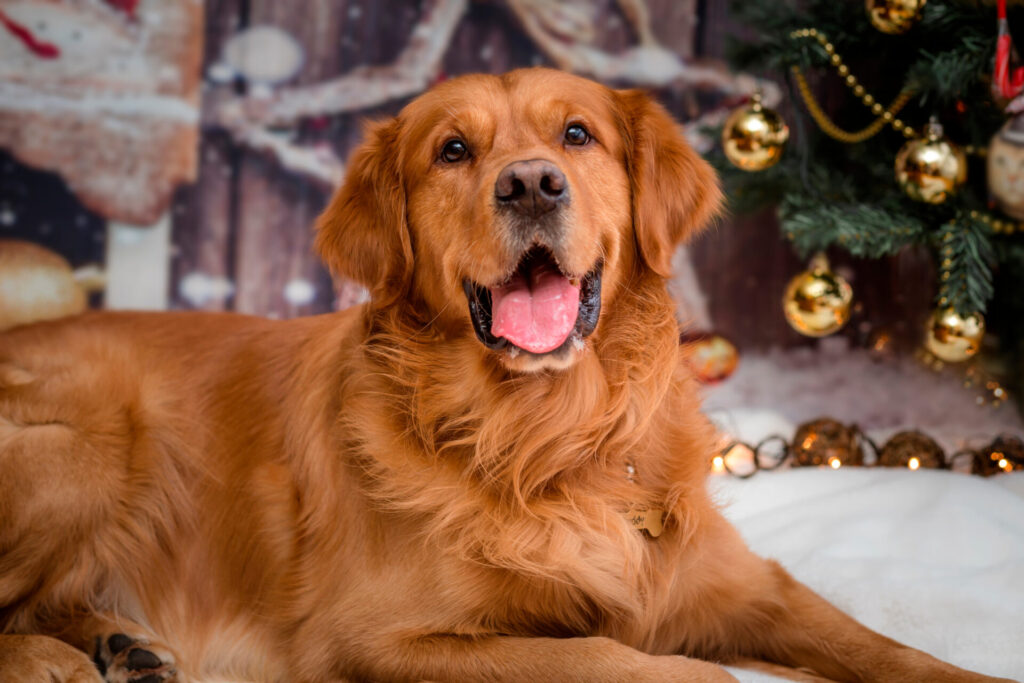
Their personality
The great thing about Golden retrievers is that all three international variants have wonderful, happy temperaments. Golden Retrievers are well known for being playful, calm and of a wonderful friendly disposition, as well as clever, with the ability to learn quickly. What they do learn, they do with consistency and reliability, retaining their obedience, as they exhibit an eagerness to please.
As we mentioned in Part 1, they get along famously with people of all ages as well as with other family pets. Surprisingly, they don’t really often bark in the way some smaller, “yappy” breeds do, and while they will notice, for example, some unexpected noise, they are not renowned as guard dogs.
Did you know, some very famous people have owned Retrievers?
Presidents Ford and Reagan both had Golden Retrievers while at the White House, with President Reagan having no fewer than six. TV host and comedian Jimmy Fallon, actress Emma Stone, singer Adam Levine, and Oprah Winfrey are or have been owners.
Golden Retrievers are not just superb pets
Golden Retrievers also make great working dogs, both for the likes of search and rescue and well as working companion dogs for the less able, such as those with sight or mobility issues. Like many dogs, they have a wonderful sense of smell that can, with training, be tuned to specific tasks such as finding missing people or detecting contraband such as drugs, plant or food products. They were used with success in the relatively recent earthquake tragedy in Turkey as well as after the collapse of the towers during 9/11 and in the aftermath of hurricanes around the world.
What care does your Golden Retriever require?
Training: As with most dogs, training your Golden Retriever ideally needs to be started when a puppy so that good habits and obedience can be instilled from the earliest age. They will enjoy any training as they are so eager to please.
Exercise: Golden Retrievers do require regular exercise, but once they receive that, they can adapt to living anywhere, which includes inner city living.
Nutrition: All dogs should receive a healthy, balanced diet related to both their level of activity and their age. However, they do require a high-quality diet with the avoidance of being fed too many human scraps.
Grooming: A regular brushing down to remove any tangles, dirt and hair your pet might be shedding,, as well as a regular (but not excessive!) bath.
The vet: as for any dog, you must keep up to date with vaccinations, but for an active dog such as the Golden Retriever it is important they have regular check-ups to identify any potential health problems that this very happy dog might otherwise attempt to hide.
The dog itself: Most importantly, ensure your Golden Retriever comes from an accredited and ethical breeder such as http://www.goldenretrieversandfrenchbulldogs.com, where you can find more information.
Do not be fooled by cheery, happy-clappy announcements of dogs for sale via, for example, social media.
In the first part of a two-part blog, we look at the origins of those wonderful dogs, Golden Retrievers.
We have to pop back to 1865 and the famous city of Brighton on the southeast coast of England. That summer, Sir Dudley Coutts Marjoribanks came across a dark yellow-coloured sporting dog (named “Nous”) while walking about the city. Sir Dudley was the 1st Baron Tweedmouth and a Scottish businessman and a Liberal politician who was originally an elected member of the House of Commons (the UK Parliament) between 1853 and 1880 before his elevation to the House of Lords (the Upper House) as Baron (or Lord) Tweedmouth.
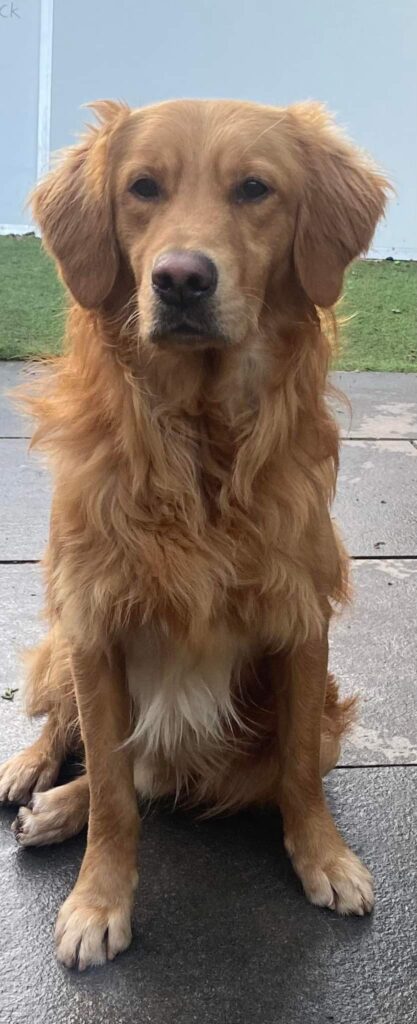
He discovered that this particular dog was the only dark yellow-coloured dog from a litter of black Wavy-Coated Retrievers owned by a local shoe repairer. At the time, black dogs were considered the best hunters, so when non-black dogs were born, they were, very sadly - and we would nowadays say, rather criminally - just disposed of. However, Nous was to have a far more happy life altogether.
Lord Tweedmouth, took ownership of Nous and brought him back home to Guisachan, his estate in Scotland. In 1868, Lord Tweedmouth bred Nous with Belle, his female Tweed Water Spaniel. Belle produced four puppies, the first litter of Golden Retrievers in the world, meaning Nous had become the founding father of one of today’s most loved breeds of dog.
Today, apart from those who see dogs as somewhat of a fashion statement, people no longer are comfortable with “designer cross-breeds”, bred very much to pander to people’s desires that can sometimes extend beyond common sensibilities. However, if being totally honest, that is somewhat how the Golden Retriever came about.
The ultimate hunting dog
As a member of the British upper class, Lord Tweedmouth was very keen to breed the ultimate dog for hunting. His own grounds in Scotland were very rural, complete with marshes, ponds, and streams. He wanted a dog that could retrieve the proceeds of his hunting activities not just over dry land, but also over water. And as shooting paraphernalia was advancing, enabling shooting in more human-accessible locations, he wanted the ideal hunting dog to be able to accompany his endeavours more efficiently and effectively in terms of retrieving his game birds.
With the breeding of Belle and Nous to produce the first Golden Retriever, the rest is, well, history!
Lord Tweedmouth had bred a dog that with its waterproof, and quite substantial coat, is happy in any environment is very active and athletic and are great swimmers. With an exceptional sense of smell, they can track down game and have relatively gentle mouths that don’t ruin the game they retrieve.
Some characteristics
As well as their excellent working abilities, ability to learn very quickly and with their overall intelligence, they are exceptionally loyal dogs, will guard their human families and are great with other household pets and farm animals. Their extremely friendly, approachable and affectionate personalities mean they also make exceptional family pets. Learning new Being so relatively easy to train means they also make great rescue dogs as well companions for those with disabilities.
While some may think all Golden Retrievers are simply “golden”, they not only exhibit three variations on the colour, namely golden, dark golden and light golden, there are three “international” variations, English, American and Canadian Golden Retrievers.
In part two of this blog, we’ll look at their characteristics in more detail.
Shade Frenchies: The French Bulldog (or “Frenchie”) remains, without doubt, one of, if not, the most sought-after and adorable breed of dog. It is friendly, sociable, easy to look after and has a cuteness factor that endears itself to everyone it meets, young and old alike.
You will no doubt be familiar with the Frenchie’s typical coat colouration - black, brindle, cream, fawn, piebald and white. However, they also now come in some quite rare, if not unusual, and perhaps even referred to as exotic colours.
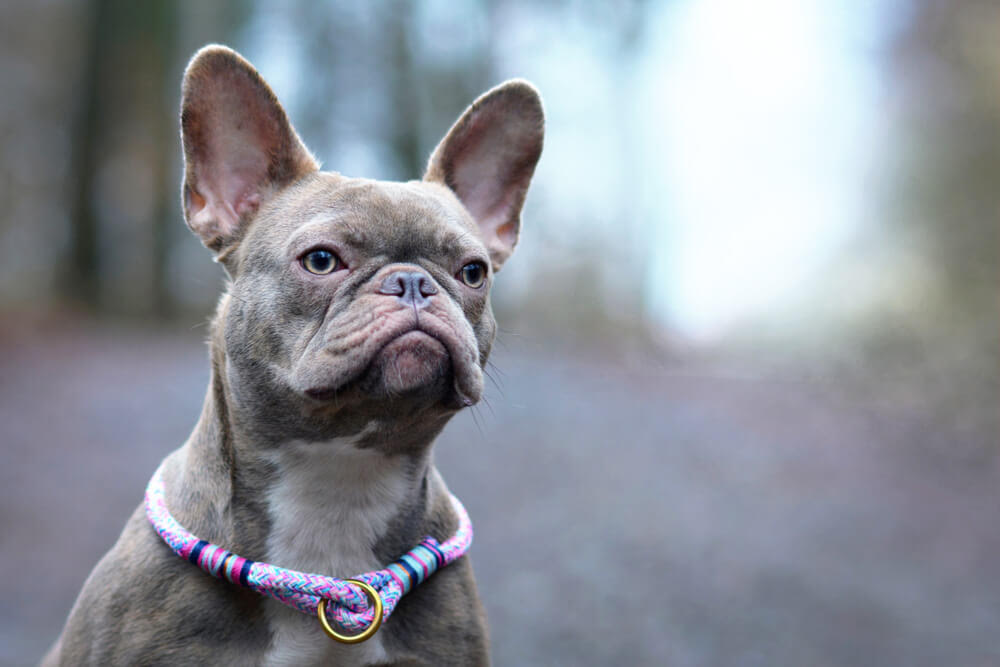
Some of the rarer Frenchie colours include Chocolate, Isabella and Lilac, with Isabella seemingly generating the greatest interest among Frenchie fanciers. However, to many, Isabella does not necessarily signify a colour. So, to explain:
So what is an “Isabella colour” in a French Bulldog?
Isabella is a French Bulldog with a somewhat pale red-brown coat that exhibits a greyish-blueish tint. For the technically-minded, if both parents carry the necessary rare recessive gene combination, the brown colouration of the offspring will be diluted. You will also notice that Isabella Frenchies are usually somewhat smaller when compared with the standard Frenchie.
And what about “New Shade”?
There is also the Lilac Isabella. This Frenchie a further and additional pairing of recessive genes resulting in a similar light brown coat, but with a more blueish accent. It is this colouration which is termed New Shade. This in essence refers to the triple gene dilution that has occurred.
With Isabella-coloured Frenchies being rare due to both genetic makeup and French Bulldogs typically producing only very small litters, this implies that new-shade Frenchies are even rarer.
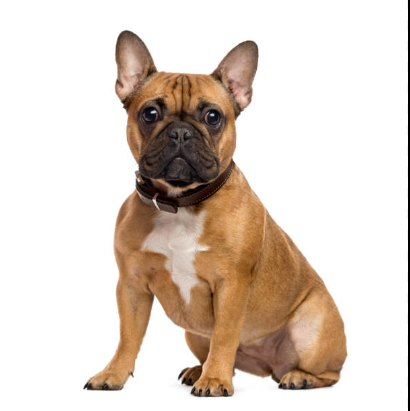
The actual coat
New Shade Frenchies can have either traditional short hair or fluffy hair coats. The fluffy Frenchie will typically exhibit longer hair around the face and ears.
So, do they make good pets?
New Shade Frenchies have precisely the same personality and temperament as regular Frenchies - they are friendly, affectionate, inquisitive, playful and really easy-going, lacking any form of aggressiveness. They are totally at ease with not only children, but with existing family pets, and adore human company and the offer of being made a fuss of combined with a good, old-fashioned cuddle.
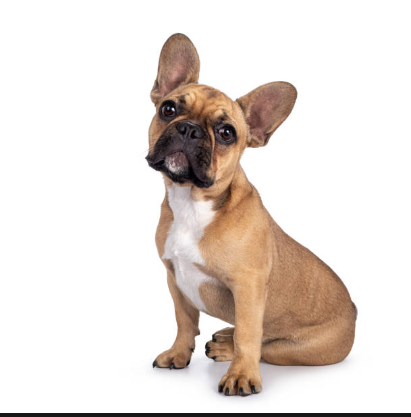
Frenchies are known to be rather clever, but they do have a somewhat stubborn streak. Sensible “positive reinforcement” training in their very early years will prove very beneficial in later years.
They like a relatively short walk, and like all Frenchies, are not too keen on very hot weather (they do need to be kept cool during hot spells) and they aren’t swimmers.
With their sensitive skin, they only need a bath once a month, they will need a brush down a few times a week (more deeply during the hair-shedding season), and you must keep their face folds and ears clean with a daily check and wipe. You can also use a special doggy toothpaste a few times a week. Also, ensure Shade Frenchies' nails are kept short if you don’t otherwise regularly walk Shade Frenchies on pavements, which can help naturally with this.

Don’t forget that with their brachycephalic flat faces and short noses can mean they are more vulnerable to respiratory illnesses, so keeping the house dust free and not smoking or vaping around them will certainly help enormously.
Bear in mind that at certain times, Fenchies will breathe more regularly through their mouths than other dog breeds, so excessive “gas” in the digestive system, can at times lead to excessive wind.
The main words of caution are you must never buy a New Shade Frenchies (or any Frenchie) “at a discount” or “good bargain price”. This shouts puppy farm and a lack of ethics, leaving you with no come-back in the event of any problems. Ensure you use a recognised, accredited French Bulldog breeder such as Royal Kennels.
The Fluffy French Bulldog, despite not being very common in France, was referred to as the “Toy” Bulldog and was associated more with England than France. While Frenchies, as they are called, have gained in popularity, obtaining one, especially bred correctly and ethically, as in the manner with which Regents Kennel breed all their dogs, can be difficult. Added to this, the more incomparable the coat of a Frenchie is, despite the availability of a vast range of patterns and colours, the more expensive it will be.

It is considered the crème de la crème of the French Bulldog breed, because coupled with its longer coat hair is now very much more sought after. The fact they are not often seen is a major plus for proud owners who like their family pet to be a little different and stand out from the crowd, something the coat hair around their ears alone demonstrates.
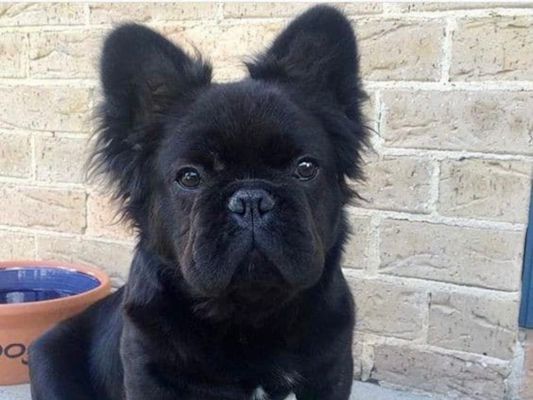
With their loyalty and incredible affection, Frenchies make superb family pets and companions dogs. They seem to get along with just about everyone and everything, most noticeably children and existing family pet dogs and cats. They just love being with people.
They are also very easy to care for, although as for any pet, you do need to plan carefully, and you do have to take into account any health issues, especially those associated with the ownership of any short-nosed (Brachycephalic) breed of dog, including eye care and skin conditions such as eczema.

They are superb companion dogs – they like, and get on, with anyone of any age, are loyal, mild-mannered and affectionate, don’t need too much exercise and are easy to groom. They are great with children and other animals, and rarely if ever show any aggressive traits. They just want to be a part of the family, but they don’t like to be alone for too great a length of time.
They can live anywhere – they are not an especially active dog, so a regular short to medium walk and a play outdoors will keep them happy and healthy. Remember, the Fluffy Frenchie is a small dog, so regular exercise coupled with the appropriate diet will prevent obesity and help maintain their health.
Frenchies are not hard to train – yes, some may say Frenchies have a stubborn streak, but they do love attention and like to please their owners. With a modicum of patience, they are very willing to learn, although this can be slightly lengthier than for some of the more active breeds, such as Terriers or those who learn by reward.
Watchdogs, not really – they are not the guard dog type and tend to be rather quiet and laid-back. Some will let you know if there is an unexpected visitor lurking. And yes, they can be somewhat territorial by nature.

Grab it and run – Fluffy French Bulldog need quite durable toys, and they do enjoy getting their teeth into a game of tug-of-war. They love to play, run around as well as socialise with other dogs.
Short-noses need watching - with their short face and much smaller nose, mention has to be made that as they don’t like the heat that much, they need to be kept cool when it’s hot and not over-exercised. And when they sleep, expect some snoring, which can actually be rather amusing. They just need that extra care and attention to prevent potential health issues, and regular visits to the vet as a preventative measure is advised.
Your pet’s grooming, welfare and care – while the hair of a Fluffy French Bulldog is somewhat longer than other Fluppy French Bulldogs, all that is needed is a weekly brush and the odd bath. However, a daily wipe-down of the face to rid those wrinkles of moisture and dirt is to be solidly recommended.
Here's a video of the lovely Chewbacca you may care to enjoy. Those eyebrow "buttons" are just so cute!
How often have you seen pictures of families with a dog in it and wondered how they managed to pull that off, or IF you can pull that off?
Such pictures are littered all over social media, so my guess is, you’ve thought about it – a lot!
Imagine if you could juggle kids and family dogs, and still have enough strength to beam at the camera. That would be awesome, right?
Well, you can!
In this article, I’ll show you how you can manage the troubles that come with having kids and a dog without going insane.
Before that, we need to go over the benefits of having a dog in your family, especially for the kids. Here’s…
Kids and family dogs that grow up around dogs learn very early that they have to look out for someone other than themselves.
Maybe you’ve already taught them to keep their room neat, unload the dishwasher, and give a hand when needed. However, learning to take care of another living being is a different responsibility entirely.
You can teach your child to walk the dog, feed him at the right time, clean up after him, and bathe the dog. Yes, they won’t perform these tasks perfectly the first few times they try, but they’ll catch up with time.
A recent study on children who had pets (dogs and cats) growing up has discovered that the kids that did were less vulnerable to illnesses. And even when these kids fell sick, their immune system responded to a shorter and less potent course of antibiotics than those that didn’t have dogs around them.
A different study found that children born to parent(s) with respiratory asthma or allergies are less likely to inherit the ailment if they had a dog in the house. It is believed that exposure to dogs at a tender age helped boost their immune system.
Everyone is familiar with IQ, however, research has shown that EQ (Emotional Intelligence) plays an important role in children’s development. With a dog to practice on, children quickly learn about EQ, a large part of which involves reading emotions in others.
Caring for a being other than oneself requires compassion. Walking, feeding, and bathing a dog when there are other interesting things to do will teach a child to be selfless. It also helps your child bond with the pet. This bond promotes the release of Oxytocin (happiness hormone) in kids' (adults inclusive) brain, making them less anxious and stressed.
Aside from that, caring for a dog helps children build healthy self-esteem. Completing small tasks like refilling the dog’s water or meal bowl helps a child trust in their competence.
How do you peel your children off the couch and away from the TV?
Get them a dog.
With a dog around them, children get to run around, play, and stretch more than those without. This isn’t just a ‘good for kids’ thing. Dog owners find it much easier to put on their running boots and jog or head to the gym.
That being said, how do you actually juggle kids and dogs without burning out?
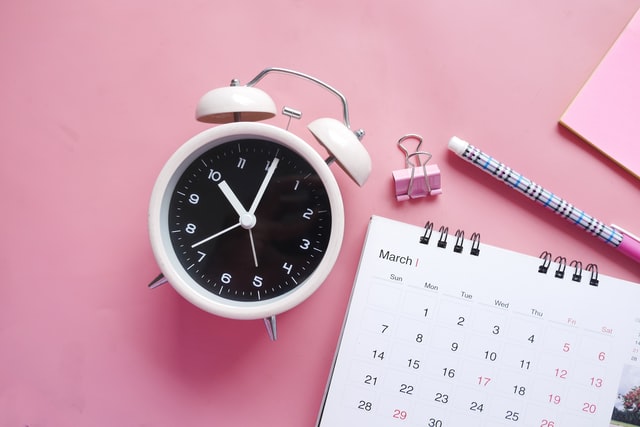
The first thing that separates families that successfully integrate a dog and one that doesn’t is a routine.
A routine that works is one that is beneficial to everyone involved. And it has a substitute in case one person is predisposed.
Establish a schedule for walking, feeding, exercising, and relieving the dog. Help your children understand the benefits of this schedule and why they should stick to it. Trust me, after some time, they’ll be the ones reminding you that it’s time to walk or feed the dog. With a routine, you can stop your dog from waking you in the middle of the night.
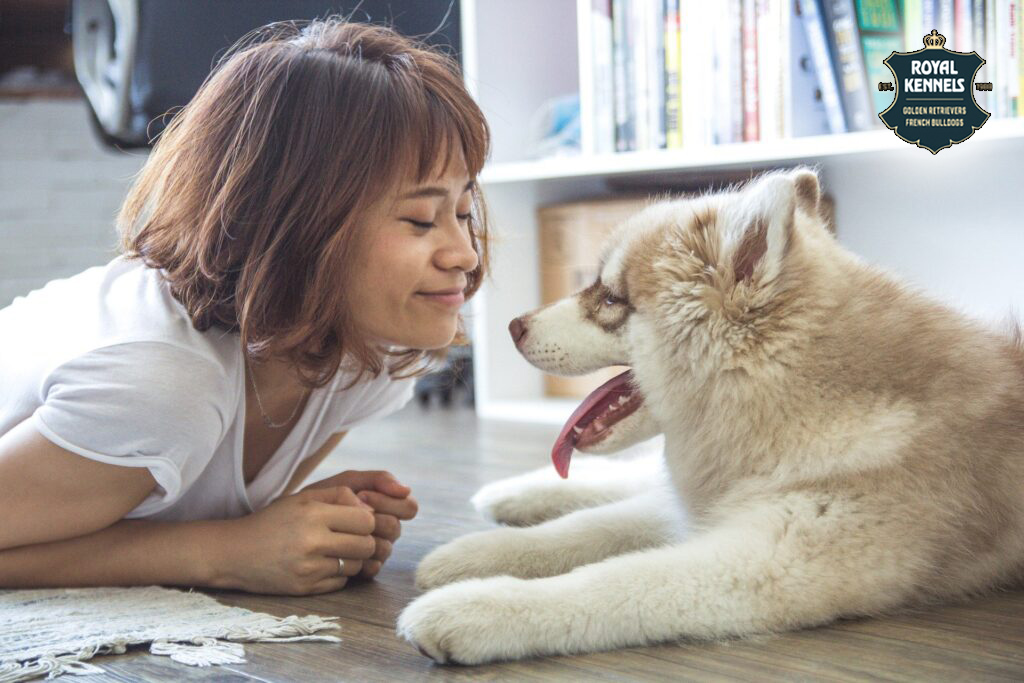
One way to make dogs and kids work is to create a safe space for them to be. Remove all toxic plants (if you have any), hide Lego pieces, and small toys that can be ingested. Hide footwears, socks, power cables, and any other thing that can cause harm to both kids and dogs.
The same goes for the backyard. You have to remove anything that can be tripped on, hurt the feet, or not suitable for play. You want them to play and have fun in the sun without you reaching for the first aid kit.
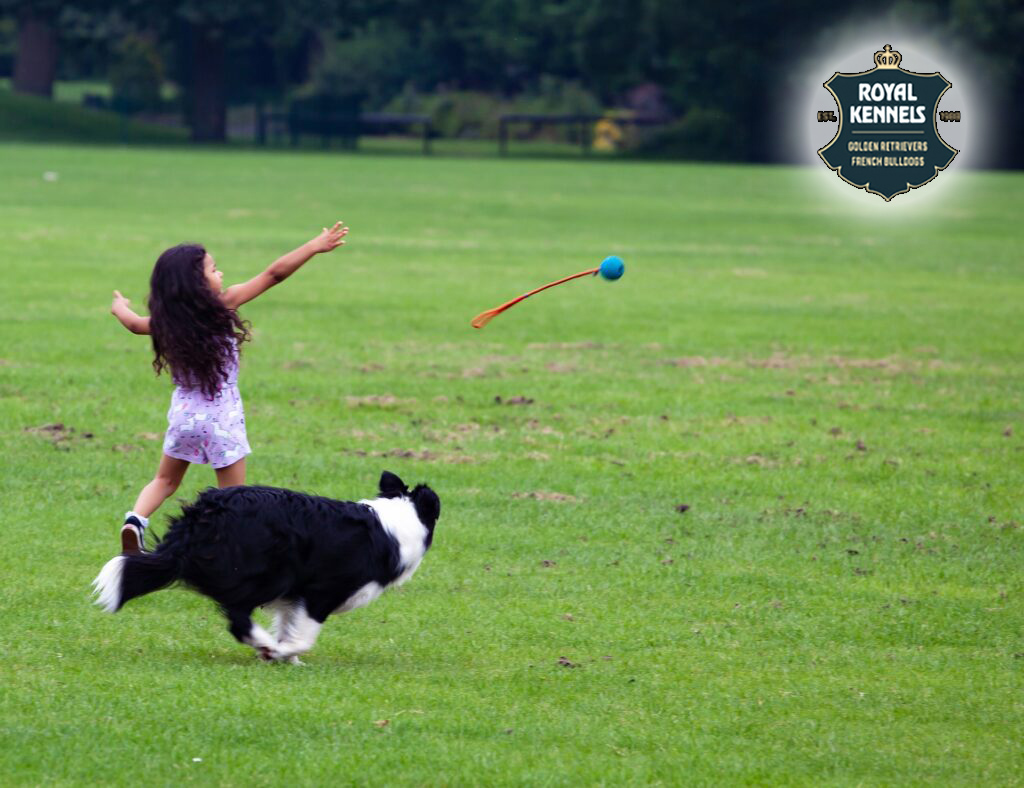
When making a schedule for your family, remember to add mind-stimulating activities to the routine. A great way to keep the body physically fit is to incorporate long walks into your day to day activities.
However, you also need to stress them out mentally too. Get your dog a food puzzle to play with, while your kids are working on jigsaw puzzles or playing monopoly.
You can encourage your kids to read a story to your dog while he’s munching on his favorite toy. This way, your dog gets to exercise his brain while your kid practices his reading skills.
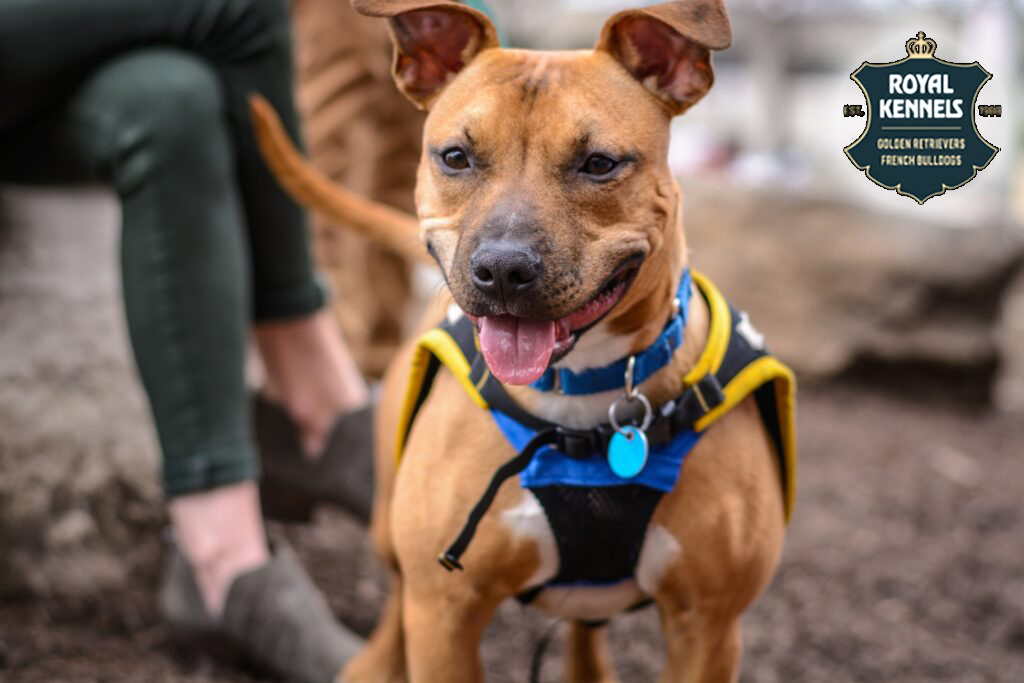
Once in a while something you never expected comes up at the last minute. You have to quickly dash to the grocery store, your kid has music practice, or whatever event takes precedence over being with the dog.
When this happens, which it will, you’ll need the help of a trusted dog walker or sitter. It could be a neighbor’s teen or a paid dog companion – BTW, you should find a way to compensate your neighbor’s child though.
This will prevent your dog from developing separation anxiety when he’s left alone, or overwhelming you with attention when you return.
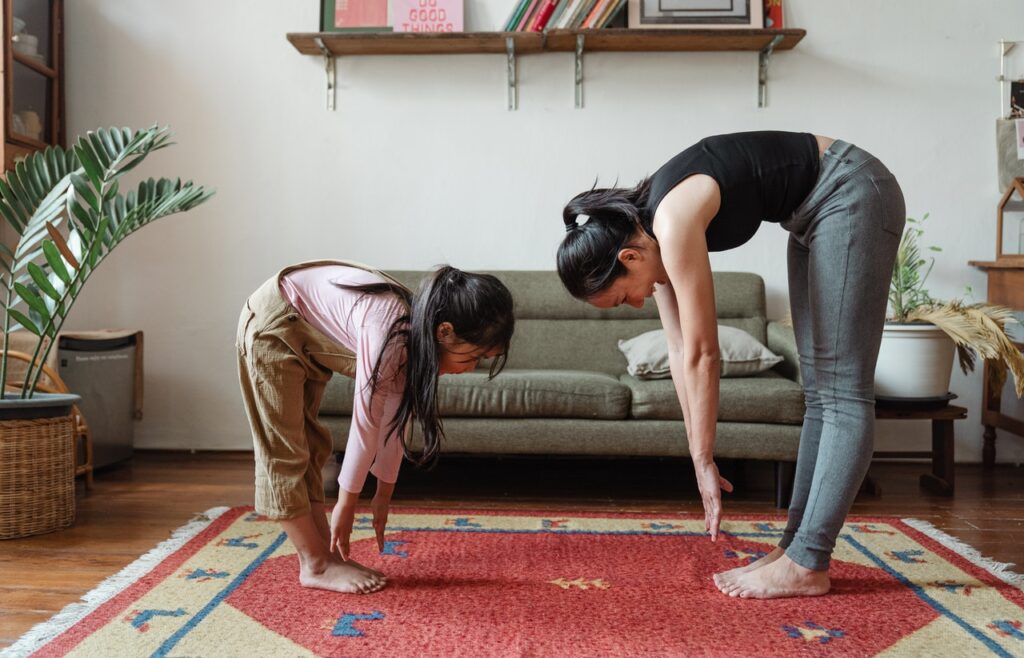
It’s very common to see regular gym members slowly withdraw with the addition of a new family member. However, if your routine is tightly packed and you can’t make it to the gym, don’t just sit on the couch or eat chocolate.
You can go for a hike, an extended walk with your dog, or just stretch right at home. There are mobile apps that show you how to use your weight as gym equipment. If yoga is your thing, clear a space, and follow some YouTube videos. You’ll feel happier, healthier, and less anxious or stressed afterward!
Remember, the longer you stop exercising, the harder it’ll be to restart or find time for it.
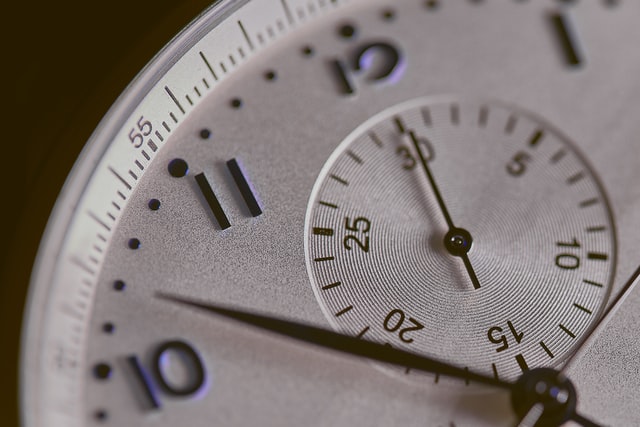
We all need some time off to rest our heads after a long day. While kids and dogs can go on playing forever, you have to include sleep time in the routine.
20-30 minutes before sleep time, put a stop to every frantic play session, and make everyone just chill out. Take the dog out for one last potty break to prevent him from waking you at night. Snuggle for at least 10 minutes with your kids before letting them doze off to sleep.
Your kids may request that pooch sleep in their bed. But, it’s up to you to decide if letting the dog sleep in their bed is a good idea. My advice? Decide before they ask so you don’t make a hasty decision.
Look, children are children. They’ll try to treat the dog like another human or a smaller version of themselves. They’ll try to drop the dog’s meal in his mouth, pass him food from their spoon, apply cream on the dog’s coat, or hug him a little bit too tight.
Say ‘No!’ very often.
It goes without saying that you need to supervise play sessions. A lot of times when a dog resorts to biting, it’s because the play was inappropriate or hurtful to the dog.
It’s much easier for an adult to read a dog’s body language. From an adult perspective, you can tell if the dog is tired of playing with the kid for the day. Is sick or in pain, or just wants to be on his own. So, teach your child to seek your permission before petting the dog.
Dogs get terrified when someone suddenly reaches out to them. Teach your child that the best way to safely interact with the family dog is to offer an open invitation. Let them stand back, open their arms out, and beckon the dog to come to them.
This serves two purposes. The dog calmly goes to the kid if he feels like doing so. And, there’s little risk of sudden aggressive behaviors towards the child.
Once the dog sniffs their hands and warms up to the kid, then it is safe to gently stroke him. However, they should use one hand to stroke under the chin, the head, and the back. This way the dog can feel where the hand is and isn’t startled by any movement.
This one boils down to empathy. Ask your child how they’d feel if the sibling started poking them while they were trying to sleep or eating.
Except the dog is licking, teach your child to steer clear of the dog’s mouth. Most bites are accidental, maybe the child wanted to get something from the dog’s mouth or place something there.
When playing fetch with the dog, teach your kids to use two balls. When the dog fetches the first one they threw, they should throw the second. The dog will drop the ball in his mouth and fetch the second ball. This way your kid doesn’t have to pull the ball out of the dog’s mouth and risk getting bit.
Remember, nobody is perfect!
The people beaming in those family pictures you fantasize about missed a couple of appointments. They sometimes forget to walk the dog, their dog soils the house once in a while, they forget some items on the grocery list and they misplace their keys too.
You just have to do the best you can to weave these tips into your daily routine, manage unwanted behaviors as they arise, and attend to your dog’s physical and emotional needs, just like you do for your children – which they are!
So you want to adopt a new dog in Thailand and have everything run smoothly.
Isn’t that the dream of all dog owners?
A dog, like any new addition to your life, is a game-changer that will affect your work, relationship, hobbies, and free time.
Many dog owners complain about how adopting a new dog is like having a baby.
Luckily for us, many people welcome babies and dogs into their homes every year. So, if they can do it… so can you!
Hopefully, this isn’t one of your ‘new year, new me’ fad. But, you’ve actually thought long and hard about your decision to adopt a dog and it is rock-solid – seriously, you should do so if you haven’t.
I’m now going to show you the smoothest way to adopt a new dog In Thailand and get the dog settled into your lifestyle.
Let’s start with what you need to do before the dog arrives.
Adopting a new dog and bringing it home is not like buying kitchenware (no offence to kitchenware). You must plan and adjust your home as well as lifestyle to accommodate the new addition. These 7 steps can help you do just that.
Dog breeds differ and so do families.
That’s why it is important to do thorough research when choosing a dog for your family and lifestyle.
Be honest with yourself!
If you love to do things indoors on the weekend or have little time left after work, you’re better off with a low-energy breed. Or if you live in an apartment or a small home, a cattle dog that needs room to run is probably the worst choice. You will have an easier time living with a French bulldog.
If you can’t decide on a breed of dog, consider taking a dog breed quiz to help you narrow your options.
Another factor you should consider is the dog’s age – do you want a puppy or an adult dog.
They both have pros and cons, so the decision is a personal one. Do you have the patience to train a puppy or the perseverance to deal with an adult dog’s baggage?
Carefully go over the behaviours you are/aren’t ready to deal with. Then pick the age of your new dog based on that.
Remember, they both have pros and cons.
While you’re at it, consider members of your household that are allergic to animals. Are they okay with a dog or do they need to make some changes that’ll help them live with the new dog?
Yes, choosing a good vet before getting a dog is the best way to go about adopting a new dog in Thailand.
That’s because many pet adoption processes require you to list the name of your vet before the application is approved. So you see, having one makes the adoption process hassle-free.
Get suggestions from family and friends. Then contact the recommended vet to let them know you are about adopting a new dog and you need information concerning their vet practice.
Find out what hours they are available and if they offer after-hours emergency service, plus how much they charge per visit so you can compare. I recommend meeting your top candidate in person so you can analyse how they interact with humans and animals.
I must warn you though, just because you don’t vibe with a vet doesn’t mean that they are not ‘good’ at what they do. Some of them are so deep into their practice that they relate better with animals than with humans.
Use your intuition. 🤷
Once you decide to work with a particular vet, go ahead and ask them to recommend a dog trainer in Thailand, food brands, and must-have pet supplies.
It’s okay to have a different preference. However, having access to professional input when you need it will make the job of caring for your new dog easier.
There are lots of dog supplies you can get for your new dog, but you don’t have to buy all of them before your dog arrives. To avoid feeling stressed and overwhelmed on the day you bring your new dog home, it is best to have the basic dog supplies in place – you can borrow some from a friend.
When you’re at the pet store or browsing online, be mindful of the size of the dog you are buying these things for. A french bulldog’s supplies are smaller than those of Mastiff or Golden Retriever, especially the sleeping bed and crate.
Here are the basic supplies you need to get started:
Look around for appropriately-sized products for your new dog. I usually advise new Nothern-Lites Golden Retriever and French Bulldog owners to get a non-slip stainless steel food and water bowl like the YETI Boomer to prevent spillage.
If you are getting a puppy, a nylon collar is a good option to start with. However, you should get something bigger and durable for when they hit adolescence – preferably one that comes with a name tag.
When buying food for your new dog, look for a brand that lists meat and proteins as ingredients, followed by whole grains such as barley or oats and vegetables such as broccoli or potatoes.
You need to pay extra attention to the first five or six ingredients on the list, as they make up most of the food. Avoid sweeteners, chemicals, and corn products and byproducts.
This should be a food brand that your vet says is okay. However, you are not going to feed your new dog this dog food immediately. You will know why later on.
A good quality bed is of utmost importance to a dog since they spend a lot of time there. You don’t have to go for something expensive, but always opt for a comfortable memory foam bed – one that matches your décor.
If you are getting a new puppy, you don’t need anything fancy yet. A basic six-foot leash made of strong, nylon material will do just fine. Avoid retractable leashes – at least, until your dog has learned not to pull on the leash.
Though most owners view a dog crate as some sort of prison, it is far from that. A good dog crate provides a ‘den’ that your dog can hide in when he wants time off from the world. It can help keep your dog calm and prevent destructive behaviours while you are away.
Since you can’t spend all day playing with your new dog, you’ll need to provide a means of relieving boredom. A good toy or two should get you started, but I recommend getting more than 4 toys. You’ll want to avoid these common mistakes dog owners make that ruin dog toys so you don’t buy toys every fortnight.
If you work from home or want to restrict your dog from accessing some part of the house, you’ll need an ex-pen or a baby gate. This is really helpful for dogs that like to explore, especially in the early days when they’re yet to understand basic “leave it” and “come” commands.
While shopping for food grab a bag of treats for your new dog. The treats should be given out during training and as a reward for good behaviour. As with the dog food, ensure to go over the ingredients of the dog treat too.
When choosing supplies such as collars, dog bed, leash, or crate, pick for the adult version of your new dog and not the puppy version. I say this because dogs grow overnight: if you purchase a puppy bed or crate, it will become small and uncomfortable for the adult dog before you know it.
Prepare your home to receive a pet before bringing in a new puppy.
Walk around your house and remove all items that might hurt a dog. Go a step further – or lower – to puppy-eye level and remove all items you don’t want them to damage e.g. USBs, power cables, shoes, socks, etc.
Even if you dislike dog crates and you’ve decided not to get one, your dog still needs a ‘den.’ I recommend creating temporary private space for your dog with plywood or cardboard until he/she starts treating the space as his spot. Visit and feed him there to make the process faster, however, make sure the kids and other pets are denied entry.
Bringing home an animal is more than just paying up the initial adoption fee. It’s your obligation to care for your new family member when they fall sick.
An emergency visit, usually in the range of 350 THB to 1200 THB often forces pet owners to make difficult and devastating decisions about their pets. Do not forget that dogs need grooming, food, worming medications, and they also need to be treated for fleas.
So, make sure you set aside money to care for your new dog. And try to separate it from your other expenses.
You won’t always be at home or have free time to spend with your dog, so make sure the decision to get a dog is not a spur of the moment or out of boredom.
Things change!
Train your dog to enjoy spending time alone so when both of you are away from each other, he won’t misbehave. Still on thinking long-term, when your dog displays a new behaviour that you don’t like, ensure that you correct him immediately.
These little things make looking after a dog less-stressful.
The day of adoption is the beginning of a new chapter and is usually the most exciting day for both humans and the new dog.
If you can, take some days off work or pick your dog on the weekend so you have time to get him settled in. Or adopt from a reputable dog breeder that can deliver to your home in Thailand.
However, avoid adopting a dog at the start of a long vacation. That’s because the dog will get used to seeing you at home and might develop separation anxiety when you have to go away.
Your new dog is filled with fear, anxiety, and other emotions. He/she will need someone beside them to comfort and assure them that everything will be okay, so have someone drive you to the pickup location or to comfort him while you drive.
Remember to take the dog collar and leash with you. And avoid making any distracting stops on the way home.
I know it is tempting to welcome the new addition with excitement. However, you must remain calm when picking up your new dog.
You can think what you like of the shelters or dog breeders, but your dog was familiar with that place. You are now moving the dog to a new and unfamiliar environment. So feel the excitement, breath, and be cool as the breeze.
I recommend signing up for obedience training classes within two weeks of ownership, even if your dog is pre-trained. These classes, usually 150 THB or less, are useful for both the owner and dog as they help establish who the boss is.
Another alternative is to search YouTube for dog training videos. However, results are not guaranteed and there’s no one to point out the little details that need to be worked on.
Just like humans, dogs thrive where there is routine. Before your new dog arrives, discuss with your family member who will be in charge of a certain dog-care regimen.
Who will feed the dog at night? Who will walk the dog in the morning and evening? What areas are off-limits to the dog? Who is responsible for grooming the dog? Etc.
These are still necessary even if you are a solo dog owner. You need to have the contact of a groomer and a dog walker in case you need help with caring for your dog.
As soon as your dog gets to his new home, you have to make him feel comfortable, safe, and familiar with his surroundings. Here’s how you can pull that off:
Once you have completed the adoption and your dog comes home with you, be prepared to witness a lot of excitement, especially when the dog gets comfortable.
Dogs are curious about their environment, so expect to see him run around and sniff everything that smells new to him.
However, your dog’s energy will dip once this phase is over. There’s absolutely nothing to worry about. The dip in energy is just your dog’s system letting go of all the stress from his time at the shelter/breeder, the ride home, and stimulation from all the new sights and smells.
Who wouldn’t sleep after going through all of that?
The more comfortable he gets, the brighter his personality will shine through. So, let him be.
Feel free to take a tour around the house – on a leash though. This is recommended to help your dog understand and familiarise himself with his new home. Only do this when your dog's energy level has returned to normal.
This is also the right time to introduce your new dog to the family or roommates.
Try to do less speaking and touching during this early stage. Your dog doesn’t know what it is like to be around you, so don’t speak or touch him when you don’t have to. He will likely think that’s a command.
You are better off snapping your finger, making a “tshh” sound, or offering treats to communicate approval or disapproval.
This will help him focus on you and try to read your body language all the time.
Your dog is going to make silly blunders, but keep your cool at all times. He is still learning his place in the new pack, how the rules work here, as well as getting used to the new house.
And to learn that, he is looking up to you – and your family member – for directions on when to be playful, quiet, or sleep.
Always work with the assumption that your new dog is not house trained – even if you got an adult dog. Check out this dog house training video and train your dog accordingly.
It will be tough and your dog will soil the house a few times, but what matters is consistency and a routine specifically tuned for him. If your dog keeps soiling the house even after completing his house training, then you should go through this article to quickly find and fix the cause of house training issues.
For most pet adoption organisations, the process of adopting a new dog is not complete until you’ve taken the animal to a vet to confirm its health status.
We recommend doing so within the first few weeks of adopting a puppy in Thailand from Northern-Lites Golden Retrievers and French Bulldogs. This visit determines whether there are underlying health issues or if their system needs to be boosted with vaccines and vitamins.
And, most importantly it is when you get to ask as many questions as possible and establish a plan for ongoing care.
If your dog has not been spayed or neutered, now is the time to make that appointment or find out when you should.
Oh, and remember to get your pet microchipped.
Your dog is used to eating a particular type of food, it is not proper to rush the switch to the new dog food you bought while getting supplies. The way to do this without risking gastric upset is by slowly adding the new dog food to the old one while deducting the old one.
For instance, let’s say you feed your dog 5 ounces of dog food each mealtime, you can slowly introduce an ounce of the new food and 4 of the old food.
Now move to 2 parts new food, 3 parts old – only when he shows no loss in appetite or gastric problems. Keep going until you’ve completely removed the old food from his diet or you run out of old food – recommended, to avoid wastage.
And, finally...
This is where most new dog owners fail.
They direct so much of their focus outward on the new dog, that they forget to monitor what’s going on in their head. Then one day when they get overwhelmed, they lose it and feel like they made a mistake adopting the dog.
That’s to be expected.
And the truth is, when you expect to feel horrible on some days, you won’t see it as a big deal when you finally do.
Understand this. Adopting and bringing a new dog into your life is a life-changing decision, but it won’t always be this way.
One day you’re going to wake up and think “huh, it wasn’t so bad after all.”
And the way you get to this point is by monitoring your thoughts and emotions. Know when you are frustrated and reel yourself back in so you can see the bigger picture.
When you feel exhausted, relax.
Some of the best dog owners I know of often miss a vet appointment and they reschedule another. They forget to walk their dog in the morning and they make up for it in the evening.
One day your dog will be tightly knitted into your routine so much that you won’t even break a sweat to do these things.
So…
Trust the process!
History of The Golden Retriever:
Dogs and humans have a historic relationship that goes back hundreds if not thousands of years.
However, when you compare them to other dog breeds, the golden retriever’s history is relatively new.
Historically bred as hunting dogs in Scotland, they make excellent family dogs. They are a medium-sized breed that usually has a dark-golden coat and is renowned for their loyalty, kind eyes, and enthusiasm for life.
But, how did they come about and who is responsible for bringing us this lovely and intelligent breed?
Dudley Coutts Marjoribanks (also known as Lord Tweedmouth) was born in 1820 as the second son of a successful Scottish banker. As a teenage boy, he had a keen interest in dog breeding. Although at the time, dog breeding was considered an admirable hobby for socially-prominent prominent persons.
He kept records of his 50-plus years of dog breeding in a leather-bound book that survived until today and is securely preserved at the Kennel Club in England.
Like most successful men from his time, Majoribanks was a property investor. One of his earliest notable investments was the purchase of the Meux Brewery (formerly known as the Horse Shoe Brewery) with part of his inheritance.
This investment, along with his directorship in the East India Company, made him a wealthy and respectable man in society.
History of The Golden Retriever:
The history of The Golden Retriever is very unique. For many years, the prevailing story of the Golden Retriever’s origin claimed that Dudley Marjoribanks’ famous yellow-coated dogs were the offspring of a group of Russian circus dogs he purchased.
However, the earliest and best-kept records of History of The Golden Retriever are in the journals of Dudley Marjoribanks, which spans the year 1840 to 1890.
In the mid-1860s, Dudley Marjoribanks acquired a yellow wavy-coated retriever, named ‘Nous’, from a litter of dark-coated retrievers with Golden Retriever characteristics. Dudley Marjoribanks bred Nous to a Tweed Water Spaniel, named “Belle” producing 4 yellow puppies that formed the foundation of the breed.
Tweed spaniels are closely related to what is now known as the Irish Water Spaniels. And were associated with the fishermen of River Tweed Valley located on the Scottish-English border.
The combination was truly exceptional, as it created a robust hunter capable of navigating both land and water to retrieve partridge, grouse, and occasionally red deer.
The offspring from this combination were then bred from, occasionally out-crossing to further water spaniels, an Irish setter, Labrador retrievers and a couple more wavy-coated black retrievers.
A History of The Golden Retriever: For the most part, Dudley Coutts Marjoribanks developed this breed quietly and away from the general public’s attention. That’s until 1908 when Lord Harcourt exhibited a collection of dogs from the breed at the Kennel Club show. And they sparked in popularity.
It was at this time that the term “Golden Retriever” was first used to describe them, which is why Lord Harcourt’s name usually comes up in reference to the breed name.
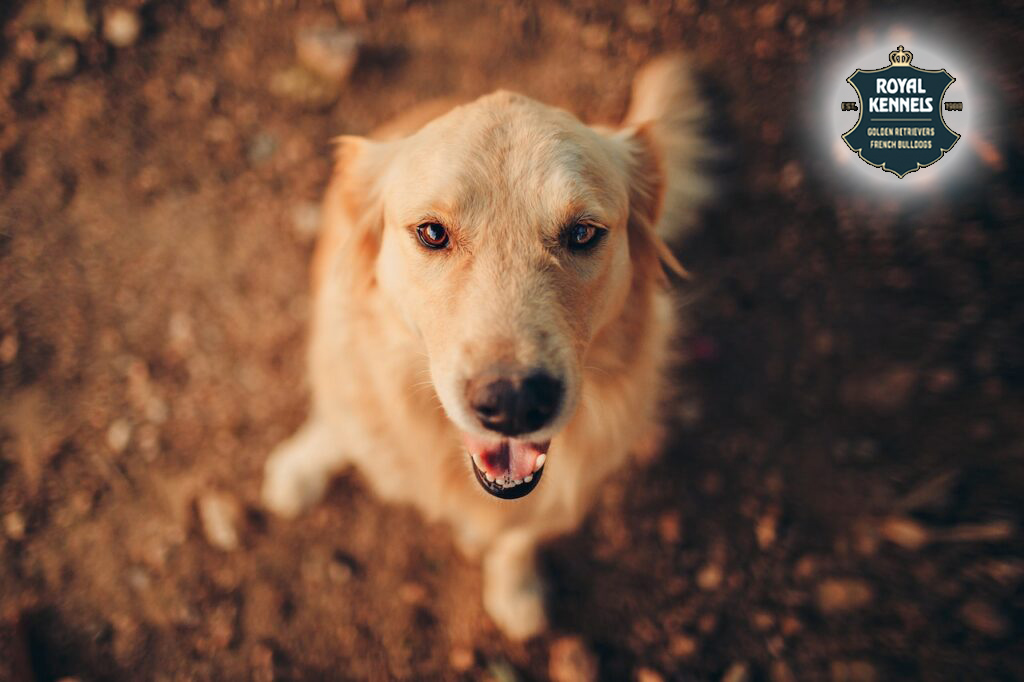
Uk kennel History of The Golden Retriever: In 1903, the UK Kennel Club became the first to allow registration of Golden Retrievers, though they were registered as yellow- or golden-colored breeds with flat coats.
They got their first showing in 1908. Then in 1913, they got a separate status when the Golden Retriever Club of Great Britain was formed.
It took 7 more years before the Kennel Club, in 1920, recognised and allowed them to assume their present name, “Golden Retrievers.”
You can find the Golden Retriever’s history on the UK Kennel Club website.
American Kennel History of The cipf-es.org Golden Retriever: A few specimens of Golden Retrievers made their way into the American canine world as far back as the early 1880s. However, it took a few decades before the American Kennel Club registered the first Golden Retriever in 1925.
And then in 1938, 25 years after their counterpart in the UK, the American Golden Retriever Club was formed. The breed has gained much popularity and love in the US.
You can find the Golden Retriever’s history on the American Kennel Club website.
Canadian Kennel History of The Golden Retriever: The Golden Retriever was first registered in Canada in 1927. Then in 1958, the Golden Retriever Club of Ontario was formed.
The Golden Retriever Club of Ontario became what’s presently the Golden Retriever Club of Canada.

When it comes to caring for a golden retriever, be prepared to live with plenty of dog hair. They have medium-length hair with a thick undercoat and an outer coat that’s water-repellent.
They shed heavily in the spring and fall, and moderately for the rest of the year. However, they should be brushed daily and will need a bath about once or twice a month.
You will need to trim your golden retriever’s claws once or twice a month to prevent them from splitting and causing foot problems. Your dog will also need help maintaining its oral health. Brushing its teeth once or twice a couple of times per week should do.
Since golden retrievers have droopy ears, they’re susceptible to ear infections. You need to inspect your dog’s ears regularly so you can treat an infection before it worsens.
Golden retrievers are active dogs that require thorough training and daily exercise to keep their minds healthy.
They work best when they have access to a play yard where they can run around and burn energy. If this isn’t available, then walking them a couple of minutes early in the morning and later in the day (to avoid hot asphalt burning their paw pads) should do. Or a trip to the free-run dog park.
Golden retrievers were bred to retrieve shot birds and small animals. So it shouldn’t come as a surprise that they like to carry things around in their mouths. A few durable toys and chew bones will satisfy this oral fixation.
Golden retriever puppies have a fast growth rate. You need to monitor and feed them a low-calorie diet that will keep them from growing faster than they should, to avoid increasing their risk of bone disorders.
An adult golden retriever should be fed up to 1.5 cups of dog food, two times per day. However, the amount needed for your dog will vary depending on its size, activity level, age, and other factors.
You should always provide fresh, clean water at all times.
Obesity will shorten your dog’s life and expose its immune system to other health conditions. So be sure to monitor the dog’s weight. If your dog seems to be gaining an unhealthy amount of weight, talk to a vet.
They’ll advise you whether to exercise it more or reduce the quantity of each meal you feed the dog.
Golden retrievers love to be where the action is – and that’s with family rather than staying in the backyard alone. They’re not suited to be watchdogs because they’re friendly with all humans.
Socialization comes naturally to them. And, when properly introduced, they get along with other canines, cats, or pets in the household.
Golden retrievers are gentle and patient with kids, but their size means they can easily knock a little child over if they get too excited. This can scare little kids, especially visiting playmates that are not used to interacting with dogs.
When a golden retriever dog has been taught to play appropriately with kids, they become a good match for families with active kids.
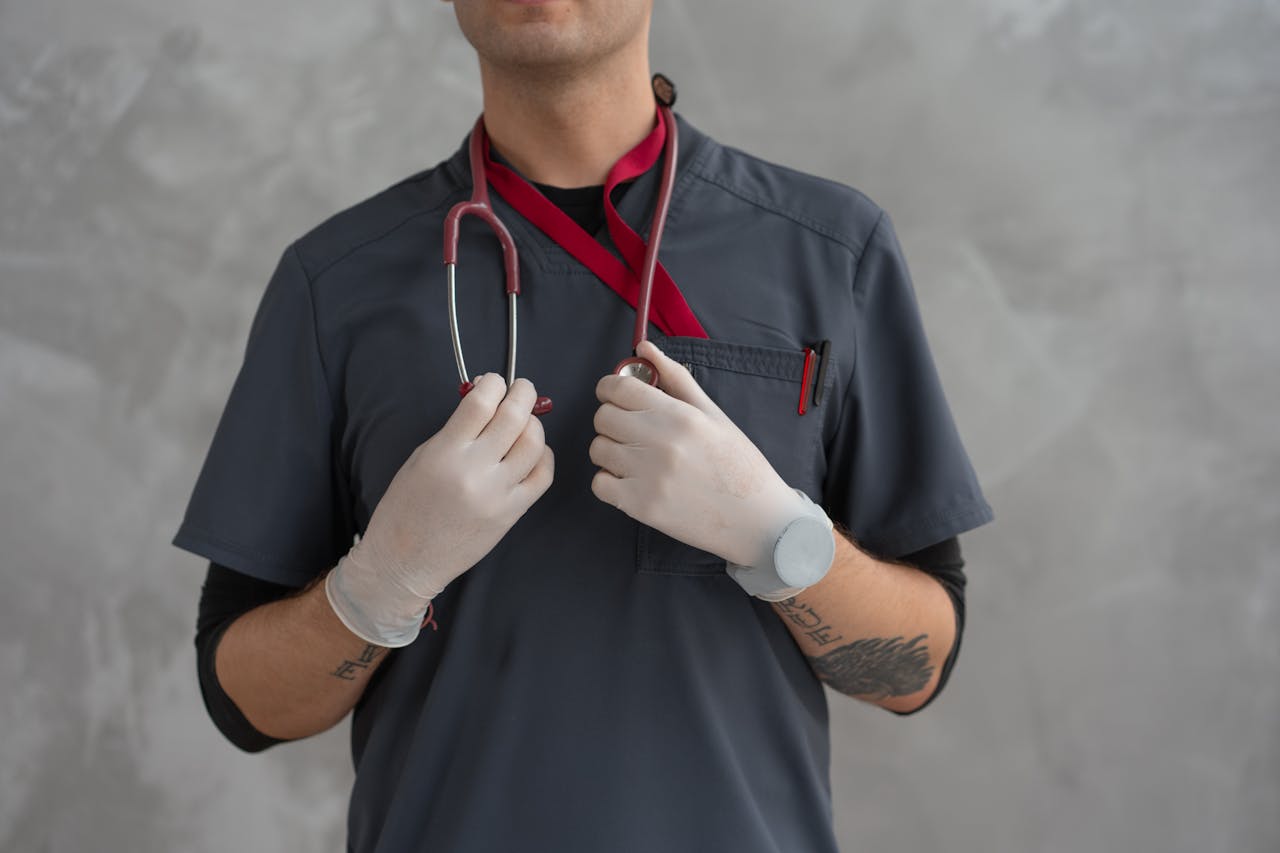
As responsible breeders, Northern-Lites Golden Retrievers and French Bulldogs strive to maintain the highest breed standards established by the UK and American Kennel Club as well as DNA-testing our parent dogs.
Dogs that are DNA tested and bred by these standards are at less risk of inheriting or developing health conditions. Conditions to be aware of include:
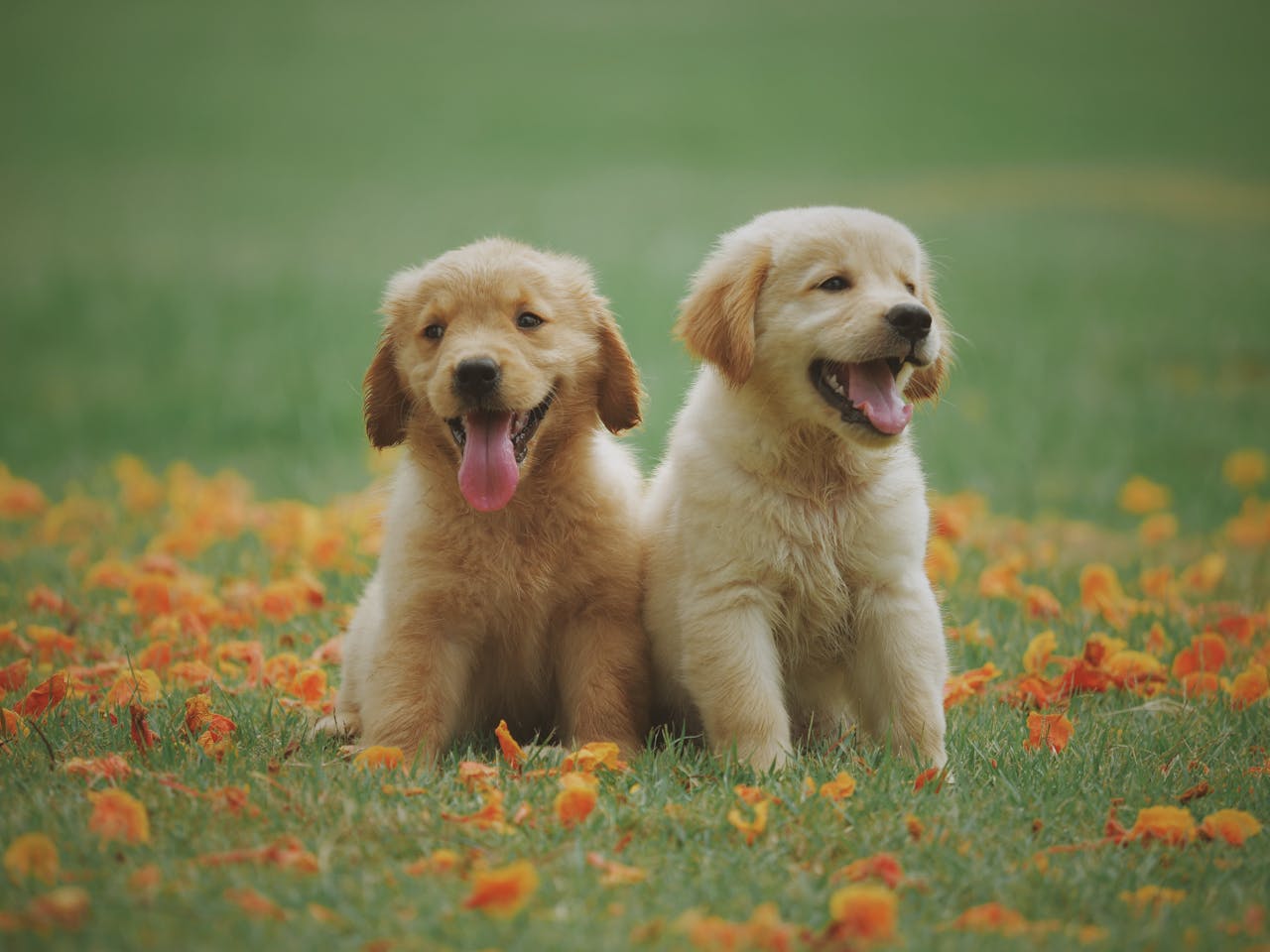
You can check your local animal shelter and rescue groups for golden retrievers in need of homes.
Or check in with Northern-Lites Golden Retrievers and French Bulldogs. We’re a family-run training & breeding kennel dedicated to producing a small number of healthy field-bred puppies each year.
We make deliveries to dog-loving families in Phuket, Bangkok, Pattaya, and Chaing Mai.
Contact us today. We might have a puppy for your family.
